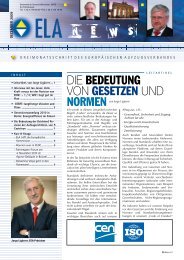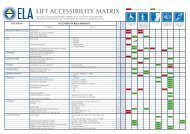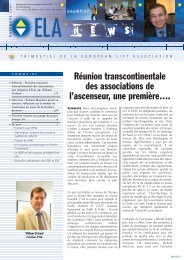WP6-Brochure-E4 brochure - ELA European Lift Association.
WP6-Brochure-E4 brochure - ELA European Lift Association.
WP6-Brochure-E4 brochure - ELA European Lift Association.
Create successful ePaper yourself
Turn your PDF publications into a flip-book with our unique Google optimized e-Paper software.
occupied by lift support systems. Also, lift machine rooms can be areas where substantial air<br />
leakage and heat loss from the building occurs.<br />
The first idea, triggered by the Linear Induction Motor lift by Otis, was to place the motor in<br />
the counterweight. This idea was soon abandoned. The motor would not be easy to reach if<br />
something went wrong, and had to be fed by a travelling cable going to the counterweight.<br />
The motor is now commonly located at the top of the shaft. To service the lift, the car is<br />
stopped just below the motor and controls and a temporary machine room is created.<br />
Some manufacturers use axial flux motors, a very compact, light, and as thin as possible motor<br />
which can be wall mounted within the reduced room available in the hoistway. These motors,<br />
first introduced by KONE, are very similar in operation to the more common radial flux designs.<br />
The stator produces a variable speed rotating magnetic field to which the rotor aligns itself at<br />
synchronous speed. Permanent magnets are affixed to a disc shaped rotor, whereas the stator<br />
has a three‐phase toroidal winding. The sheave is integrated in the rotor to achieve greater<br />
compactness.<br />
Figure 3‐17. Disc Permanent magnet synchronous motor (source: KONE)<br />
This design has been expanded to higher power applications. Increasing the disk‐shaped motor<br />
further would have led to impractical diameters while the axial force caused by the permanent<br />
magnets would have increased dramatically, requiring large and expensive bearings. The<br />
solution was found with the application of the dual rotor concept. The stator diameter<br />
dimensions fitted nicely, while the magnet forces of the two rotor parts balanced each other<br />
[9].<br />
29

















